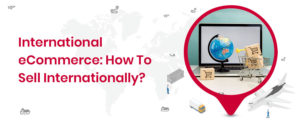As the internet is easily accessible by people and with the rise of online selling, international eCommerce is growing like a deuce. Today, geographical borders and demographics are no longer a spanner in the business. For example, you can study the European market efficiently by sitting in India.
The international eCommerce business is like a ship sailing in the ocean of uncertainty, where this ship may have to fight large waves and withstand furious storms, or it may discover lots of treasure or a city underwater.
Unfortunately, challenges in cross-border eCommerce are scandalous. You do know foreign customer perception of your product, what trend they follow, or the culture they devote to. But, if done correctly, the international market has the potential to double or even quadruple your eCommerce sales. Selling internationally has a set of rules and practices; let’s understand those.
What is International eCommerce?
International eCommerce sells products online to customers living in other countries. Year by year, many e-retailers are expanding their business globally. According to Statista, the total eCommerce sales account for 4.9 trillion USD, and by 2025 the e-commerce share in global sales will be 24.5%. So, if you haven’t gone international, now is the time.
For international eCommerce, you must scrutinize your products’ trends in the country you want to sell. Then focus on other factors like customers’ preferences, behavior, level of competition, and government policies for international companies.
Studying these above factors will help you in selling internationally.
What Are The Practices Of international eCommerce?
Before entering the international market, ensure you have adequate information about the dos and don’ts of that market. Then, start small in the beginning by launching a few SKUs in the target market and analyzing the market response. Once you get a green signal, then start expanding. Here are five international eCommerce practices you must know.
Research Your Target Market
The first phase starts with researching the target customers of the country you’re planning to expand your eCommerce business. Your research should include gathering information on the total addressable market (TAM), competitors, customer preferences, and government policies and grants.
You can use free tools like Google Analytics, Google Trends, and Search Console for the research.
Strategy to Enter The International Market
After executing your research, it’s time to dip your toe into the water. Do not get excited, be cautious about every action, and start small. There are few options for entering the international market.
- Launch limited products to understand consumer behavior and product performance.
- You can merge with local dealers who have been in the business and know the market better or acquire local businesses of that country to enter the market.
- Optimize your website for international buyers or create custom websites for the target country. That will work for markets like China or regions where people prefer to speak their native languages.
Set up International Shipping Options
Having a reliable shipping partner is pivotal and plays a decisive role in cross-border selling and affects your customer satisfaction. The solution is to find a reliable carrier who has been in the business and promises to provide secure and timely shipping to customers. But finding a carrier with all these advantages is a struggle. That is why it is better to take help from a platform like NimbusPost, which lets you choose one among many cost-effective courier partners.
Localize Everything
Localizing your services according to your target customer interests will help you gain customer loyalty. You’ll agree that the products which are hits in India might not perform the same in China or other countries. That’s why tailoring your product according to your target customers is the key to the success of your international business.
Take Support from Government Policies
If the foreign country’s policy supports your business, it becomes easy to grow there. The government’s business and tax policies are vital in entering new countries. Some countries’ governments favor new business players and FDI, and some don’t, so they impose taxes and trivial rules and regulations on the entry of new businesses.
Setup Payment Method
Most international customers refuse to buy products because their preferred payment options are unavailable, or they’re hesitant and do not trust that your checkout system is secured. This is one reason for the high cart abandonment rate. Research local businesses’ payment systems and use the same for cross-border transactions. Choose a payment system that is secured and trusted in the target country.
What are the international issues of eCommerce?
Unreliable Logistics Partner
An unreliable carrier is a barrier to customer satisfaction. If your logistics partner does not work properly, customers might get faulty products and see delivery delays. On the other hand, customers expect that your product reaches them on time and in good condition, so logistics in International eCommerce businesses become a challenge.
You can try and test shipments from different carriers partnered with NimbusPost, they provide courier recommendations, a rates calculator, and a performance engine to choose the best courier partner.
Culture, Language, and Localization Issues
In international commerce businesses, language is a struggle because of consistent requirements to offer customer support. For example, suppose your customer is from a country where English is not popularly spoken; it would be challenging for him to understand and for you to offer support even though his browser is set to English.
The solution is to understand your target customers and localize your product for them.
Currency and Payment Issues
In many countries, a direct bank transfer is preferred by people, and it is challenging to optimize your payment process for receiving payment from local banks; that’s why most international businesses do not allow bank transfers. Global payment gateways like Paypal seem to be a one-stop solution for currency and payment issues, but many countries like Pakistan have banned these gateways.
Conclusion
As Uncle Ben said– “with great power comes great responsibilities” international eCommerce has many challenges, but here you have the opportunity to become a million-dollar market cap business. Many brands have cracked the code and earned significant profits, and if you’re disciplined with your strategies, you can do it too. For example, finding reliable logistics will solve one major problem right here if you sign up for NimbusPost.




